Looking for a Fishing Charter? Michigan has one of the most diverse fishing opportunities. Whether you are fishing Lake Michigan, Lake Huron, Lake Erie and St. Clair or one of the many rivers and inland lakes, here are the fish species you can expect to catch"
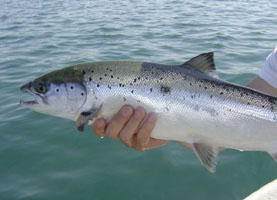
Identification - The interior of the mouth of an Atlantic salmon is entirely white. Adult Atlantic salmon are graceful fish, deepening rearward from a small pointed head to the deepest point under the dorsal fin, then tapering to a slender caudal peduncle which supports a spreading and slightly emarginate caudal fin. Adults have black spots predominantly above the lateral line, although its caudal fin is usually unspotted. Atlantic salmon are distinguished from the Coho salmon because they have fewer than 13 rays in the anal fin. While they mature they take on a silver blue sheen. (see the Atlantic salmon fish cam)
Habits - Each year there are about 20,000 Atlantic salmon released into the St. Marys River in late May. The fish have been taken in Lake Huron and Lake Michigan. In the 70s Michigan planted some 20,000 young Atlantic salmon in the AuSable River. Atlantic salmon, (land locked) are long jumpers. Whereas steelhead go skyward, they porpoise like a whale.

Identification - The interior of the mouth of the Brown Trout is entirely white. Lake run brown trout usually are silver, just like coho. However, once out of the water the typical large round spots, accented by a light colored hollow, begin to show. Normally the anal fin has only 9-10 rays, which separate it from other trout and salmon with the exception of the occasionally caught Atlantic salmon.
Habits - In the Great Lakes, and Michigan fishing for brown trout are near-shore fish and are taken by shallow water trolling, surf casting or pier fishing. Usually brown trout in the Great Lakes are plumper than their inland lake a nd stream counterparts (similar to football shape) because of the super abundance of forage in the Great Lakes.

Identification - Best identifying characteristic is teeth set in black gums. The base of the tail flares like the handle of a canoe paddle, offering the angler a grip sufficient to lift the fish. Like the coho, the interior of the mouth will also be gray or black. Tail spots are usually restricted to the top half of the tail, but may also appear on the lower half. The anal fin usually has 15 to 17 rays. Chinook Salmon do not jump and roll as much as coho, but have tremendous power and make long reel-screaming runs.
Habits - Open-water fishing is the best in spring and summer, as with coho. Migration to parent streams begin in late ummer, with heavy concentration at stream mouths. Stream fishing peaks sometime in September, at the onset of spawning runs.
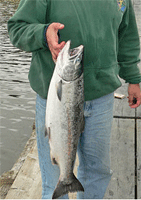
Identification - Tail spots are concentrated on the top of the tail. The interior of the mouth is usually gray or black, but the gums are whitish. The anal fin usually has 12 to 15 rays. Also, while on the line, coho often roll sideways, many times entangling themselves in the tackle.
Habits - In spring and summer, coho can be found in open waters near concentrations of alewives or smelt - usually within 10 miles of shore in the upper 20 to 40 feet. In August and September, they concentrate in schools near mouths of the parent streams. Sometime in September, they begin ascending the spawning streams in waves.
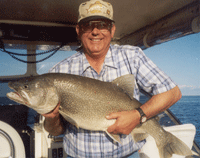
Identification -Color pattern is mostly gray above and white below with creamy white mottling on the back, grading to spots on the side - no red or pink. The tail is distinctly forked.
Habits - Pre-eminently a deep-water and cold-water fish. In spring and during fall spawning season, when water is still very cold, lake trout may be taken in lake edge shallows. They too will run up rivers in the fall, and become quite accessible to anglers below the large dams which block and concentrate the runs. Summer and winter, they are taken by trolling and still fishing or "bobbing" in 50 to 200 feet of water. Large inland lakes near the Great Lakes are also likely sites. Some large lakes, well inland, maintain populations with annual plantings.
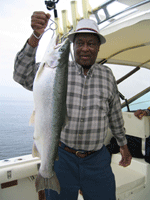
Identification - The interior of the mouth is white, unlike either coho or chinook. Also, the entire tail area is potted. Cheek plates and sometimes a line along the side are a rosy pink. Normally, the anal fin has 10-12 rays.
Habits - Steelhead spawn in the spring, as early as March, but they begin entering the spawning streams as early as the preceding September. A recently introduced summer-run strain of steelhead may enter the streams in mid-summer. Special early and late seasons are held to take advantage of these runs. Stream fishing is prime in October, November, March and April. In late spring and summer, steelhead can be found in big water - usually within a mile of shore at depths of less than 50 feet.
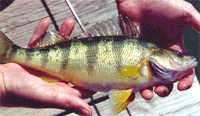
Identification - This is the little cousin of the walleye and sauger. Like its larger cousins, the perch is excellent eating and a favorite of most people who like fish. Habits -Perch are found throughout the state of Michigan. They are school-running fish and you should drift or troll and try various places and depths of water until you begin to catch them. Many anglers say you should fish from 20 to 50 feet deep to take the bigger perch, and your hook should be held a foot or so off bottom. Spring and fall, perch favor shallow water (4 to 9 feet depth) and will bite all day long. During the rest of the year, they are found in deeper water and bite best in morning and evening. They do not normally feed at night.

Identification -Walleye and sauger are look alike cousins that are members of the perch family. Although they are not exceptional fighters, they excel as table fare.
Habits -These tasty fish are found mainly in large lakes and streams and in many areas of the Great Lakes. Look for submerged bars and deep rock areas close to shore. Fish close to points or river mouths, in shallow water during spring and fall, in deep water during summer. Both species should be fished in early morning, afternoon, evening, and up till midnight. Dark and windy days are also suggested. Night is best in summer. Both are school-running and range widely over a lake.
Michigan Charter Boat Association has over 600 Captain members
Download a Membership Application